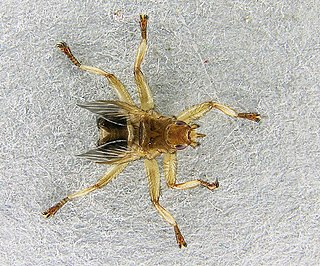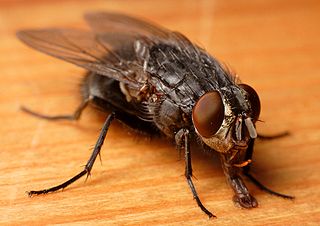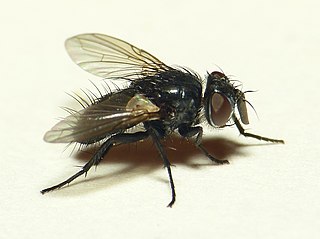
The skimmers or perchers and their relatives form the Libellulidae, the largest dragonfly family in the world. It is sometimes considered to contain the Corduliidae as the subfamily Corduliinae and the Macromiidae as the subfamily Macromiinae. Even if these are excluded, there remains a family of over 1000 species. With nearly worldwide distribution, these are almost certainly the most often seen of all dragonflies.
Fritz Konrad Ernst Zumpt was a German entomologist who worked mainly in Ethiopia, but also to a lesser extent in Uganda, Ghana and Mozambique. He is best known for his work on Diptera and the associations between insects and African mammals, as well as for his work on myiasis.

Hippoboscidae, the louse flies or keds, are obligate parasites of mammals and birds. In this family, the winged species can fly at least reasonably well, though others with vestigial or no wings are flightless and highly apomorphic. As usual in their superfamily Hippoboscoidea, most of the larval development takes place within the mother's body, and pupation occurs almost immediately.

Calliphora is a genus of blow flies, also known as bottle flies, found in most parts of the world, with the highest diversity in Australia. The most widespread species in North America area Calliphora livida, C. vicina, and C. vomitoria.

Bengalia is a genus of blow flies in the family Calliphoridae with one authority considering the genus to belong to a separate family Bengaliidae. These bristly and, unlike the greens and blues of most calliphorids, dull coloured flies, are especially noted for their relationship to ants. Little is known of their biology and life-cycle, although adults of many species are kleptoparasitic on ants and will snatch food and pupae being carried by ants or feed on winged termites. The apt name “Highwayman Fly” was given by an early observer of their way of robbing ants. Very little is known about their breeding habits. The genus is found in the Afrotropical and oriental region with one species from Australia possibly a recent introduction.

Chrysoritis, commonly called opals or coppers, is a genus of butterflies in the family Lycaenidae found mainly in southern Africa and particularly South Africa.
Burnupia is a genus of small freshwater snails or limpets, aquatic gastropod mollusks that are traditionally placed in the family Planorbidae.

Megalobulimus is a genus of air-breathing land snail, a terrestrial gastropod mollusk in the subfamily Megalobuliminae within the family Strophocheilidae.

Lipoptena is a genus of Hippoboscidae, known as louse flies or keds.

Sarcophaga is a genus of true flies and the type genus of the flesh-fly family (Sarcophagidae). The members of this cosmopolitan genus are frequently known as common flesh flies.
Microlynchia is a genus of biting flies in the family of louse flies, Hippoboscidae. There are four known species. All species are parasites of birds. Microlynchia differs from Pseudolynchia in the presence of minute ocelli and a differently shaped scutellum.

Ornithomyinae is a subfamily of the fly family Hippoboscidae. All are blood feeding parasites, for the most part on birds, though some have mammals as hosts.

The Laelapidae are a family of mites in the order Mesostigmata. The family is also referred to in the literature as Laelaptidae, which may be the correct spelling.

Ptilonyssus is a genus of mites in the family Rhinonyssidae. There are at least 230 described species in Ptilonyssus.

Blondeliini is a tribe of parasitic flies in the family Tachinidae. Larvae are parasitoids of other insects, mostly beetles and caterpillars. Although nearly cosmopolitan, its greatest diversity is in the New World and especially in South America.

Lepyrus is a genus of true weevils in the beetle family Curculionidae. There are more than 70 described species in Lepyrus.
Senotainia is a genus of satellite flies in the family Sarcophagidae. There are more than 70 described species in Senotainia.
Cosmina is a genus of flies in the family Rhiniidae.

Rhiniidae is a family of flies in the order Diptera, and formerly included in the Calliphoridae. There are around 30 genera and 370 described species in Rhiniidae.>

Leptomonas is a genus of parasitic flagellate protist belonging to family Trypanosomatidae and subfamily Leishmaniinae sensu Maslov & Lukeš 2012. It is a monoxenous parasite of mainly Hemiptera, Diptera, and Siphonaptera insects.














